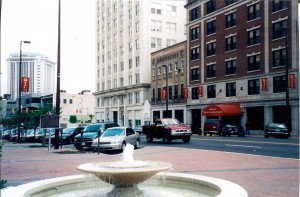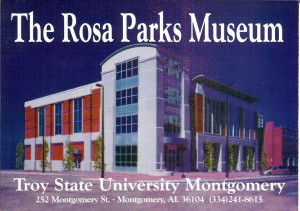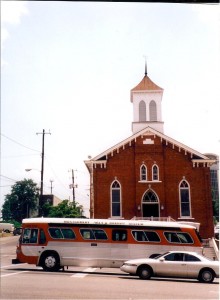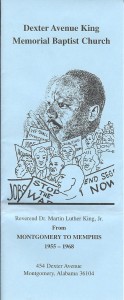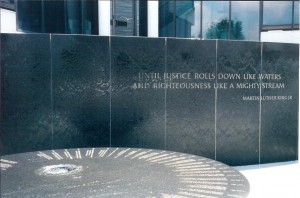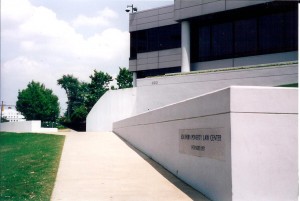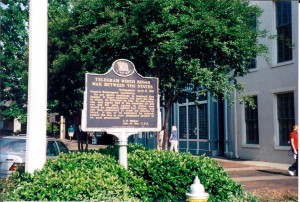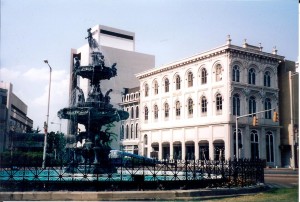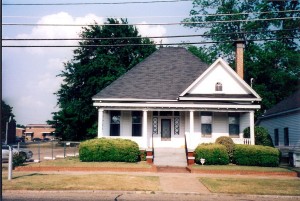On day two, we woke up in Montgomery and breakfasted at a chain restaurant named (to the disappointment of us tourists) for New York City. It was here that I experienced my first cultural/linguistic barrier: what exactly is tea? In the South, “tea” is what I would describe in my northern way as iced tea. For me, “tea” is a beverage in which tea leaves are steeped in boiling water, mixed with milk and sugar, and drunk while hot. I’m a bit of an addict. Did I say “a bit”? OK, it’s the only thing some mornings that gets me out of bed. It took awhile to explain this to the waiter. Not Sweet Tea, I explained, but hot tea! At the New York bagel place, I eventually received something that looked dangerously decaffeinated, but it was at least hot, so I hoped for the best. Note to self: carry Lipton tea bags in future.
As it turns out, Montgomery is well suited for visitors. It had a shuttle trolley running a loop around the town with parking for it at the Old Depot, where there is a robust visitors center. My friend and I boarded the trolley where we were joined by three well-coiffed and immaculately dressed white women in their late 50’s. They made small talk with us before one of them claimed that she had been on the Montgomery bus when Rosa Parks was put off of it. She went on to describe the scene, noting that Mrs. Parks was put off closer to her home, not downtown, and claiming that what we are taught in school should not always be held as true. Throughout her account, the female African-American trolley driver treated the woman and her claims with respect even as she disrupted the information the driver was trained to provide. On the one hand, the driver tried to orient us with the events of the Montgomery bus boycott while, on the other, our companion sought to undermine the account. In truth, the older woman seemed a bit embarrassed by all the fuss over the buses. The exchange was so interesting that my friend and I nearly missed the stop for the Rosa Parks Museum, which sits at the corner where Mrs. Parks was arrested. Afterwards, we could not help but wonder if the older woman was really present for Rosa Parks’ arrest, or if she had seen other black women put off a bus and, over time, placed herself at this particular event. In fact, even Rosa Parks had been put off a Montgomery bus prior to her arrest in December 1955. In any case, at the urging of our trolley driver, we got off the bus at the same spot as Parks. We were not arrested; we headed for the museum named for her.
The Museum was engrossing. It began with a room featuring the various characters at play in Montgomery in the 1950’s, then moved us into a room with a 1950s-era Montgomery bus that played a video enacting the events of Rosa Parks’ arrest on 1 December 1955 on the windows. As we watched, my companion filled me in on a debate among historians of the Civil Rights Movement as to whether Rosa Parks’ resistance and subsequent arrest that day was planned. Parks had been a long-time member of the NAACP, and had attended a folk school in Tennessee where she was trained in methods of non-violent resistance to institutional racism. As we watched the display on the bus, my companion assured me that Parks’ arrest was planned by Civil Rights leaders targeting a transportation system that was heavily supported by Blacks, but which resisted efforts to desegregate. Later, however, when we raised the idea that the protest was planned with an African-American acquaintance of ours who had spent her life in Montgomery, her reaction was one of shock. Of course, she insisted, the boycott was a spontaneous response.
Again, it is at moments like this where I feel like I am not a stakeholder in this part of history. The Civil Rights Movement proved that it could mobilize around Rosa Parks, and they turned out to be effective in their aims and held to their non-violent principles in the means by which they pursued them. It seems unimportant to me whether it was spontaneous or not. But then, it’s not part of my personal history. The museum moved us forward in the story, describing the boycott in detail and noting that the Parks family eventually moved to Detroit to escape threats to Rosa’s life, and she had not moved back. In fact, she died in Detroit in 2005, living closer to my hometown than her own.
We emerged from the museum in the middle of the day. We had spent so much time there that we had to strategize about how to spend the rest of the day. Our next stops on that trolley would take us to the Hank Williams Museum and Memorial. Since our interest was more in history than music, we returned to the depot for the trolley that would take us to the Dexter Avenue Baptist Church, where Martin Luther King preached during the mid-1950s.
The afternoon had now become hot, not oppressive, but enough to make its presence felt. The church was simple and prominent, and the staff was welcoming, particularly while visitors to the basement and upstairs disrupted their daily work. After looking around at the church and mural of Civil Rights leaders, we rejoined our original trolley driver and were content to enjoy the air conditioning. Our next stop was the Civil Rights Memorial, which sits in front of the Southern Poverty Law Center.
Designed by Maya Lin, the architect who designed the Vietnam Veterans Memorial on the National Mall, the memorial lists a number of significant events of the Civil Rights Movement, beginning with the Brown v. Board of Education decision in 1954 and ending with ML King’s assassination in 1968, listing fatalities that occurred at the listed events. While I thought the symbolic use of water was effective, I wondered at the choice of beginning and ending events. Did the struggle end with King’s death? Begin with the Brown decision? Do we have enough historical distance to memorialize it yet?
As we finished at the Memorial, we had a decision to make. The one historical trolley stop we had not made was at the White House of the Confederacy, which is located next to the capitol building in Montgomery. We had planned to visit Confederate historical sites, but now that we were at the site, and we could see that the past is still such a part of the present, my companion was less comfortable with financially supporting this piece of Alabama’s history. It turned out to be free, so we went in, but we found it to be empty except for us and staffers, so it felt sleepy and shuttered. We wandered about, but with little guidance from the staff, we soon pressed on.
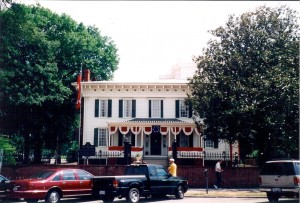
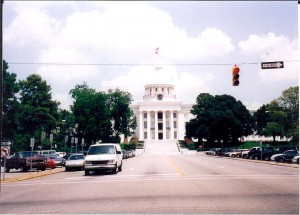
We were now feeling the heat of the day and were starting to tire. We headed back to the Depot hoping to find lemonade, a piece of the South that had lived in my northern imagination. Surely, we could easily stop for lemonade and ice cream everywhere, I thought. Unfortunately, I was wrong about that; the recommended restaurant was closed. Instead, we headed to the F. Scott Fitzgerald home, an apartment in a four unit house in a residential neighborhood of Montgomery where he lived while stationed in Montgomery and met his wife, Zelda. Unfortunately, by the time we found it, the museum was also closed. We headed back to Dexter Avenue downtown for hot dogs and lemonade that was not homemade, and began walking the street taking in historical markers. Our shuttle driver had told us that they were filming a movie about Rosa Parks with Angela Bassett, and we found the store fronts decorated for Christmas even though it was May.
It was getting later in the day, and the streets were losing their bustle. We began to feel increasingly isolated, and when some men loitering in front of the theater began inviting us to join them for the evening, we decided to get in the car and try to find the house Martin Luther King lived in while he was pastor at the Dexter Avenue Baptist Church. The house was not open, but we were able to find it.
At this point, we were tired, so we headed back to the hotel where we made up dinner and planned to indulge in ice cream for dessert. We set out on a hunt for it, but failed to find anything. So far, two days into our trip, our efforts to find comfort food had failed miserably, but we had explored some very rich history.

